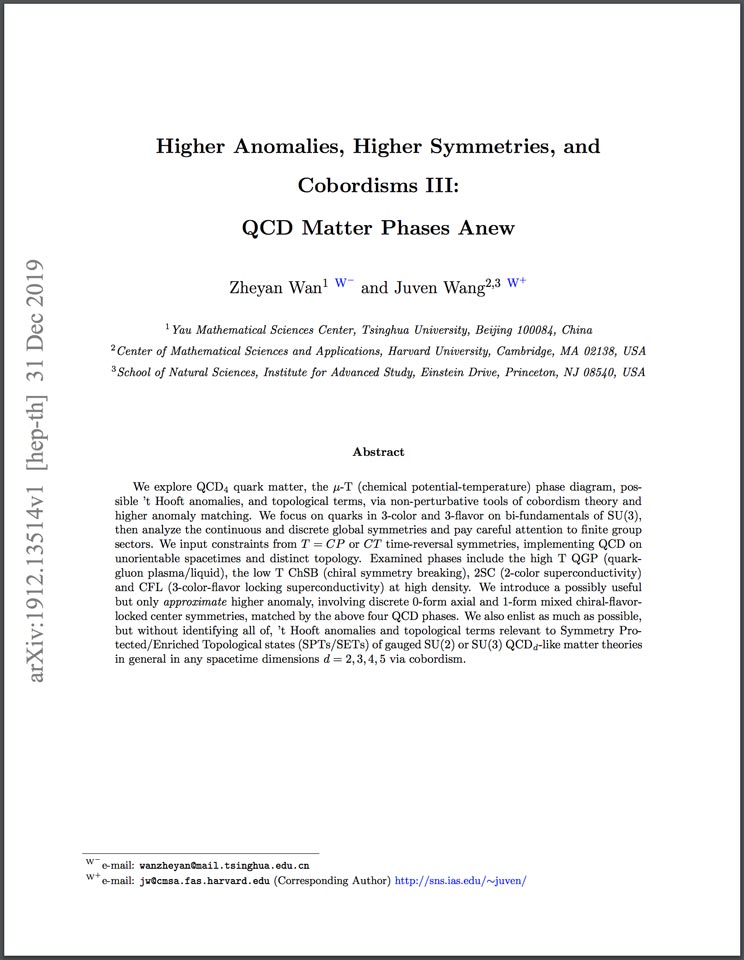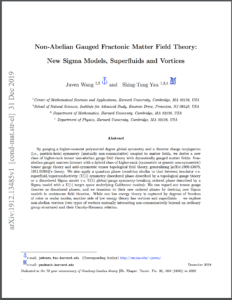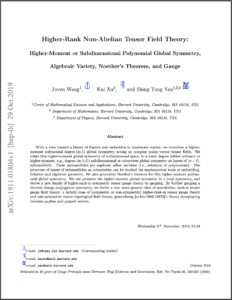

Title: Higher Anomalies, Higher Symmetries, and Cobordisms III: QCD Matter Phases Anew
Zheyan Wan, Juven Wang
Abstract: We explore QCD4 quark matter, the μ-T (chemical potential-temperature) phase diagram, possible Hooft anomalies, and topological terms, via non-perturbative tools of cobordism theory and higher anomaly matching. We focus on quarks in 3-color and 3-flavor on bi-fundamentals of SU(3), then analyze the continuous and discrete global symmetries and pay careful attention to finite group sectors. We input constraints from T=CP or CT time-reversal symmetries, implementing QCD on unorientable spacetimes and distinct topology. Examined phases include the high T QGP (quark-gluon plasma/liquid), the low T ChSB (chiral symmetry breaking), 2SC (2-color superconductivity) and CFL (3-color-flavor locking superconductivity) at high density. We introduce a possibly useful but only approximate higher anomaly, involving discrete 0-form axial and 1-form mixed chiral-flavor-locked center symmetries, matched by the above four QCD phases. We also enlist as much as possible, but without identifying all of, Hooft anomalies and topological terms relevant to Symmetry Protected/Enriched Topological states (SPTs/SETs) of gauged SU(2) or SU(3) QCDd-like matter theories in general in any spacetime dimensions d=2,3,4,5 via cobordism.

Title: Higher Anomalies, Higher Symmetries, and Cobordisms II: Applications to Quantum Gauge Theories
Zheyan Wan, Juven Wang, Yunqin Zheng
Abstract: We discuss the topological terms, the global symmetries and their' Hooft anomalies of pure gauge theories in various dimensions, with dynamical gauge group G, the Lorentz symmetry group GLorentz, and the internal global symmetry Ge,[1]×Gm,[d-3] which consists of 1-form electric center symmetry Ge,[1] and (d-3) form magnetic symmetry Gm,[d−3]. The topological terms are determined by the cobordism invariants (Ωd)G' where G' is the group extension of GLorentz by G' which also characterize the invertible TQFTs or SPTs with global symmetry G'. The Hooft anomalies are determined by the cobordism invariants (Ωd+1)G" where G" is the symmetry extension of GLorentz by the higher form symmetry Ge,[1]×Gm,[d-3]. Different symmetry extensions correspond to different fractionalizations of GLorentz quantum numbers on the symmetry defects of Ge,[1]×Gm,[d-3]. We compute the cobordism groups/invariants described above for G= U(1), SU(2) and SO(3) in d≤5, thus systematically classifies all the topological terms and the' Hooft anomalies of d dimensional quantum gauge theories with the above gauge groups.

Title: Non-Abelian Gauged Fractonic Matter Field Theory: New Sigma Models, Superfluids and Vortices
Juven Wang, Shing-Tung Yau
Abstract: By gauging a higher-moment polynomial global symmetry and a discrete charge conjugation (i.e., particle-hole) symmetry (mutually non-commutative) coupled to matter fields, we derive a new class of higher-rank tensor non-abelian gauge field theory with dynamically gauged matter fields: Non-abelian gauged matters interact with a hybrid class of higher-rank (symmetric or generic non-symmetric) tensor gauge theory and anti-symmetric tensor topological field theory, generalizing [arXiv:1909.13879, 1911.01804]'s theory. We also apply a quantum phase transition similar to that between insulator v.s. superfluid/superconductivity (U(1) symmetry disordered phase described by a topological gauge theory or a disordered Sigma model v.s. U(1) global/gauge symmetry-breaking ordered phase described by a Sigma model with a U(1) target space underlying Goldstone modes): We can regard our tensor gauge theories as disordered phases, and we transient to their new ordered phases by deriving new Sigma models in continuum field theories. While one low energy theory is captured by degrees of freedom of rotor or scalar modes, another side of low energy theory has vortices and superfluids - we explore non-abelian vortices (two types of vortices mutually interacting non-commutatively) beyond an ordinary group structure and their Cauchy-Riemann relation.

Title: Higher-Rank Non-Abelian Tensor Field Theory: Higher-Moment or Subdimensional Polynomial Global Symmetry, Algebraic Variety, Noether's Theorem, and Gauge
Juven Wang, Kai Xu, Shing-Tung Yau
Abstract: With a view toward a theory of fracton and embeddon in condensed matter, we introduce a higher-moment polynomial degree-(m-1) global symmetry, acting on complex scalar/vector/tensor fields. We relate this higher-moment global symmetry of n-dimensional space, to a lower degree (either ordinary or higher-moment, e.g., degree-(m-1-ℓ)) subdimensional or subsystem global symmetry on layers of (n−ℓ)-submanifolds. These submanifolds are algebraic affine varieties (i.e., solutions of polynomials). The structure of layers of submanifolds as subvarieties can be studied via mathematical tools of embedding, foliation and algebraic geometry. We also generalize Noether's theorem for this higher-moment polynomial global symmetry. We can promote the higher-moment global symmetry to a local symmetry, and derive a new family of higher-rank-m symmetric tensor gauge theory by gauging. By further gauging a discrete charge conjugation symmetry, we derive a new more general class of non-abelian rank-m tensor gauge field theory: a hybrid class of (symmetric or non-symmetric) higher-rank-m tensor gauge theory and anti-symmetric tensor topological field theory, generalizing [arXiv:1909.13879]'s theory interplaying between gapless and gapped sectors.
